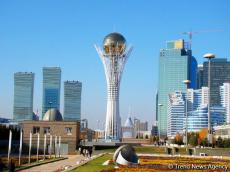Today.Az » World news » Kazakhstan to match emissions to environment to European volume
18 November 2019 [17:43] - Today.Az

By Trend
The concept of the transition to the ‘green’ economy in Kazakhstan sets goals for decrease of CO2 emissions in electricity production, Member of the Directors Board of the Kazakhstan’s Solar Energy Association Yernar Bilyalov told Trend. According to Bilyalov, the main volume of emission accounts for three Kazakh sectors: electricity production using fossil fuel, processing and mining industries, and transport. “Majority of the emissions account for electricity production and for boilers, i.e. fossil fuel burning sources. They make the most significant contributions to total the total volume of emissions: 40 percent of total emissions including 50 percent of particulate emissions, 47 percent of sulfur dioxide and 60 percent of nitric oxide,” the official said. As noted by Bilyalov, the significant part of the emissions is due to the use of low-quality coal and lack of efficient equipment to control air pollution at power plants and regional heating plants. Thus, the concept of Kazakhstan’s transition to the ‘green’ economy sets targets for decrease of CO2 emissions in electricity production compared to the current volume by 15 percent by 2030, and 40 percent by 2050. Furthermore, matching sulfur dioxide and nitrogen emissions volume to the European volume is planned by 2030. In this regard, according to Bilyalov, Kazakhstan’s government represented by the country’s Ministry of Energy, is constantly working on improving conditions for implementation of renewable energy sources (RES) projects. Currently, 83 RES objects of 936.8 MW capacity are operating in Kazakhstan including 18 wind parks, 27 solar parks, 35 hydropower plants and three bioelectric stations. Some 15 objects of 405.17 MW of capacity were launched this year. “All RES objects in Kazakhstan are operating to reach the set target. For example, Burnoye Solar-1 and 2 operating in Kazakhstan’s Zhambyl region decrease CO2 emissions by 204,605 tons a year. Karaganda region’s Gulshat Solar Power Plant decreases emissions by 78,590 tons a year, and Turkestan region’s Zadarya solar park decreases emissions by 29,268 tons a year,” he said. Bilyalov added that it is the RES development that will provide for ecology improvement and emissions decrease in the country in the future.
|